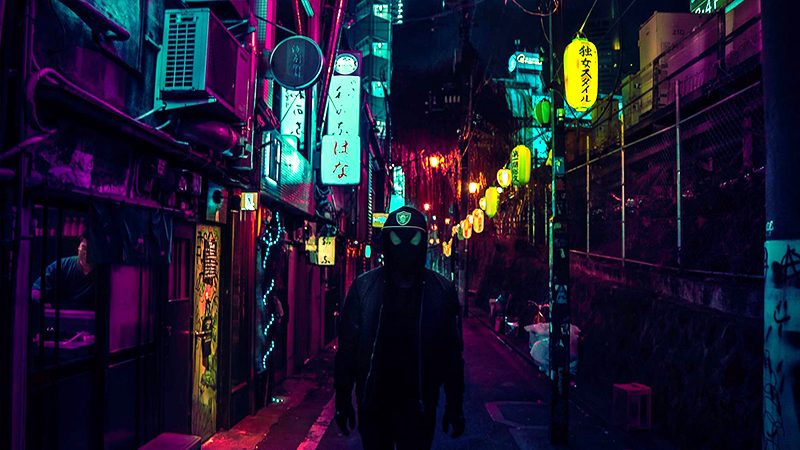Growing up in the 1990s, the cyberpunk aesthetic was the commonly accepted vision of the future. Every form of media, from movies and books, to increasingly realistic video games, was paying tribute to the genre that had become a science fiction staple over 10 years earlier with the release of William Gibson’s debut novel Neuromancer (1984), along with other classics such as Ridley Scott’s Blade Runner (1982), and Katsuhiro Otomo’s seminal anime Akira (1988).
The early 80s had seen the the advent of neoliberalism, and from that point onward our visions of the future had taken a striking turn. In the cyberpunk world, technological progression was seen as an inevitability, it was a force that would be slowly integrated into human consciousness both internally and externally, and the rise of the mega-corporation, sown from the seeds of a neoliberal economic ideology, was going to produce a world that was much less shiny and space age than had previously been imagined. Darren Anderson remarks that the aesthetic of cyberpunk is “traditionally a hi-tech world that is environmentally, socially, even morally in decline”, a world where skyscrapers rise so high as to block the light from the sun, and down on the forest floor of this concrete jungle there exists a messy and dilapidated world of darkness, an underworld lit by splashes of neon light reflecting off the puddles in the rain.

Both Gibson and Scott had imagined this future as a sort of dystopian blend between East and West in which huge monopolistic corporations had come to supplant the need for democracy. In Blade Runner, the Tyrell Corporation, a biotech company which produces ‘replicants’ (ultra-human-like androids) from a giant pyramidal monolith on the outskirts of a Japanised, dystopian Los Angeles, promises a product that is ‘more human than human’; whereas Neuromancer’s neo-Chiba City is a debauched world run by giant multinational corporations called zaibtatsus which control every aspect of day to day life in The Sprawl: “The zaibatsus, the multinationals that shaped the course of human history, had transcended old barriers. Viewed as organisms, they had attained a kind of immortality.”
The foresight of the early cyberpunk writers and directors of the 80s, especially in comparison to many sci-fi writers of the 60s and 70s, was as Anderson states, to understand that the future “has always been a scrapyard, with pieces of what is to come scattered through the past and present. Indeed, [cyberpunk’s] saving grace is that it recognizes, as other futurology often fails to, that the future will be a collage and it will be considerably older than the present”. In other words, what cyberpunk realised is that the future would not be entirely futuristic. Elements of the old would still be there, constantly merging and intermingling with the new. Technology would not help to replace the current system, but would accelerate its growth. Cities of the future would not be created from the razed ground of past cities, they would be built on top of the ones we currently lived in.

What had starkly affected this vision, along with the general pessimism towards the future caused by neoliberalism, was a kind of determinism about the influence of a rising Japanese economy as a threat to the America-led world order. Early cyberpunk was awash with neon lights and futuristic electronics, with Japanese signs adorning the front of every shop window. This is largely to do with the fact that in the 80s, Japan was seen as the world’s fastest rising power. The Japanese car industry was surpassing America’s, they were dominating the global electronics industry, and even buying up New York City landmarks. Some commentators had started to argue that the Japanese economy could well surpass the US economy in coming years, creating a new world superpower on a tiny island, and conjuring up images of a claustrophobic overpopulated neo-Japan not too dissimilar to that described in Neuromancer.
Although this wasn’t to be the case, these suspicions were still well and truly justified going into the 90s in which there was a general fascination among the youth about the futuristic sensibilities of Japanese culture. Western media was flooded with an amalgamation of Japanese products and images, all representing the ‘other side of the world’ in which the future was supposedly happening right now. For the 90s child who had grown up with Sega, Nintendo, and Playstation; who had religiously watched the americanised version of Power Rangers (originally Kyōryū Sentai Zyuranger in Japan); who had been force fed images of Gundam, Transformers and other toys from Bandai and Tomy on every Saturday morning TV ad; who had collected the Japanese editions of Pokemon cards and Tamagotchis; and who’s football teams were even sponsored by Japanese multinational corporations (the English star teams of the 90s, Manchester United and Arsenal, were sponsored by Sharp and JVC respectively), the certainty of a Japanese cyberpunk future seemed inevitable.

But as William Gibson has stated “the future is already here, it’s just not evenly distributed”. As we moved into the 21st century, the Japanese economic bubble burst, and the visions of the Japanese-American dystopia started to seem like forgotten dreams. However, the fictionalised accounts of a cyberpunk future, which had seemed to so accurately predict the way the world was changing throughout the 90s, had slowly started to subvert what the future was becoming. The aesthetic imagery of cyberpunk had on some levels been realised perfectly, and had on some levels become a kitsch fictionalisation of a future that might have been. A Western child of the 90s visiting modern Tokyo for the first time may be surprised how little had changed in the 20+ years between her imagining of the city and its current form. The long streets of flashing billboards and neon signs which once seemed like a city of the future have now become a relic of their time. Just as the retro-futurism of the 50s and 60s brings up a nostalgic feeling of a future that never came to pass, so does the cyberpunk imagery of the 80s and 90s in a 21st century world.
Japan’s economy and influence in the West had started to stagnate but in its place a whole host of new future worlds became possible. The speed of transformation of Chinese cities in the 21st century, along with the huge technological developments in South Korea, Singapore, Taiwan, and Hong Kong, had paved the way for a new kind of world. No longer were the futures imagined in the cyberpunk classics merely predictions, they were themselves becoming a creative springboard which artists, architects, designers, and photographers could use to create the world around them. The fictional worlds of the past necessarily create the present; the imaginary has an unbreakable bond with the real. We’re moving into cyberpunk 2.0.
Pictures 1 and 2 courtesy of Yoshito Hasaka and Liam Wong.


I enjoyed this
LikeLike
Cheers. Appreciate it 🙂
LikeLiked by 1 person
Pingback: Cyberpunk 1.0: Visioni del futuro - Cyberpunk news
Pingback: Cyberpunk 2.0: Re-imagining the Future | Blue Labyrinths
Cyberpunk is my favorite genre and I’m glad that it seems to be picking up momentum!!
LikeLike
Pingback: Unbuilding Walls, Part 1: Brick and Mortar | Blue Labyrinths
Pingback: Cyberpunk 2.0: Re-imagining the Future > Seekalgo
Pingback: From Cyberpunk to Solarpunk: Technics and the Cities of the Future | Blue Labyrinths